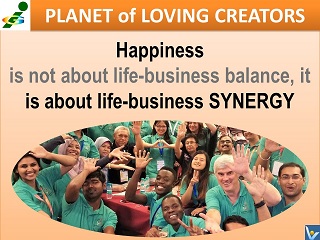|
Creativity
Creativity
is not about inventing something totally new, it is about making new
synergistic! connections. You don't have to be a special kind of
person to be creative
everyone can do it. It's not about
who you are, it's about what you do. You just need to start looking for
multiple solutions rather than settling for just one, and give yourself
permission to be playful and inquisitive, flexible and versatile...
More
Systems Thinking
Your should master systems
thinking if you wish to discover winning business synergies. Systems
thinking "focuses on the whole, not the parts, of a complex system. It
concentrates on the interfaces and boundaries of components, on their
connections and arrangement, on the potential for holistic systems to
achieve results that are greater than the sum of the parts. Mastering
systems thinking means overcoming the major obstacles to building the
process-managed enterprise
for every business
process is a whole system."2...
More
Harnessing the Power of
Diversity
Diversity is a specialized term describing a
workplace that includes people from various backgrounds and
cultures, and/or diverse businesses. You can inspire
systemic innovation
and find a strategic competitive advantage in an
organizational and cultural context by seeking to leverage, rather than
diminish, opposite forces. People with different cultural, educational,
scientific, and business backgrounds will bring different frames of
reference to a problem and can spark an exciting and dynamic
cross-pollination of ideas...
More
Enterprise Strategy
Corporate strategy seeks to develop
synergies by sharing and coordinating staff and other resources across
business units, investing financial resources across business units, and
using business units to complement other corporate business activities...
More
Creating Competitive
Advantage Through Capabilities
The opportunity for your company to
sustain your
competitive advantage is determined by
your
corporate
capabilities of
two kinds distinctive capabilities and reproducible capabilities
and their unique combination you create to achieve synergy...
More
Effective
Leadership
Leadership
is imperative for molding a group of people into a
team, shaping them into a force that serves as a
competitive business advantage. Leader know how to make people function
in a collaborative fashion, and how to
motivate
them to excel their performance. Leaders also know how to
balance the individual team
member's quest with the goal of producing synergy an outcome that exceeds
the sum of individual inputs. Leaders require that their team members forego
the quest for personal best in concert with the team effort.4...
More
Leadership-Management
Synergy
To maximize your long-term success you should
strive to be both a manager and a leader and to
synergize their functions.
Merely possessing management skills is no longer sufficient for success as
an
executive
in
today's business world. You need to understand the differences between
managing and leading and know how to integrate the two roles to achieve
organizational success...
More
10 Commandments of Innovation
Synergize.
Cross-pollinate
ideas,
leverage diversity, create synergies...
More
Achieving Synergy through
Coaching
Coaching
brings more humanity into the workplace. "Effective coaching in the
workplace delivers
achievement,
fulfillment and joy from which both the individual and organization
benefit."1 These three components achievement, fulfillment, and
joy are synergistically interlinked and the absence of any one will impact
and erode the others. "Learning without
achievement quickly exhausts one's energy. Achievement without learning soon
becomes boring. The absence of joy and
fun erodes the
human spirit."1...
More
Cross-functional Management
(CFM)
Cross-functional management (CFM)
manages business processes across the traditional boundaries of the
functional areas. CFM relates to coordinating and synergizing the activities
of different units for realizing the superordinate cross-functional goals
and policy deployment. It is concerned with
building a better system for achieving such cross-functional goals as
innovation,
quality,
cost, and delivery...
More
Real Time Business
Development
Real time development brings about
change and learning
simultaneously - not separating the two. This approach is about "how to
transform the development so that it means transforming the business whilst
learning at the same time
continuously improving and learning and getting a business pay-off as an
integral part of it. This means embedding development into how we do
business and seeing it as part of doing business."14...
More
Systemic Innovation
Innovation
used to be a linear trajectory from new knowledge to new product. Now
innovation is neither singular nor linear, but
systemic. It arises from
complex interactions between many individuals, organizations and their
operating environment...
More
Mutual Creativity in
Business Partnerships
Mutual creativity is a shared mind-set. By
learning to be creative together, you increase the chances of constructively
sorting through your differences, which encourages you to go further. In an
opportunity-maximizing strategic alliance, continued joint creativity
leads to regular improvement, outperforming what any single change can do...
More
Case in Point
Amazon.com
New business model developed by
Amazon.com
creates value for customers
by offering a synergistic combination of the following benefits:
-
Shopping convenience
-
Ease of purchase
-
Speed
-
Decision-enabling information
-
A wide selection
-
Discounted pricing
-
Reliability of order fulfillment
No single aspect of Amazon.com's
business
model is sufficient to create a
sustainable competitive advantage. It is the synergistic combination of
all of these information services and logistical processes that creates
value for customers and comprise Amazon.com's competitive advantage...
More
Case in Point
GE
"Integrated
diversity" is a term used by
Jack Welch,
the legendary former CEO of General Electric, to define a learning culture.
He described "integrated diversity" as the
elimination of boundaries between businesses and the transferring of
ideas from one place in the company to another. "Integrated diversity means
the drawing together of our thirteen different businesses by sharing ideas,
by finding multiple applications for technological advancements, and by
moving people across businesses to provide fresh perspectives and to develop
broad-based experience. Integrated diversity gives us a company that is
considerably greater than the sum of its parts."2
Toyotas global
competitive advantage is based on a
corporate philosophy known as the
Toyota
Production System.
Much of Toyota's success in the world markets is attributed directly to
the synergistic performance of its policies in human resources
management and
supply-chain networks....
More
Building Synergistic
Partnerships...
The Five
Organizational Learning Disciplines...
Cross-Pollination of
Ideas...
Leveraging the Power of
Trust...
Coherence...
Synergizing Your
Innovation Portfolio...
Venture Investing...
Case in Point
Silicon
Valley Companies: Using Innovation Portfolio...
Case in Point
Ford
Motor Company...
Case in Point
Think Tools...
Case in Point
GE Equity...


|